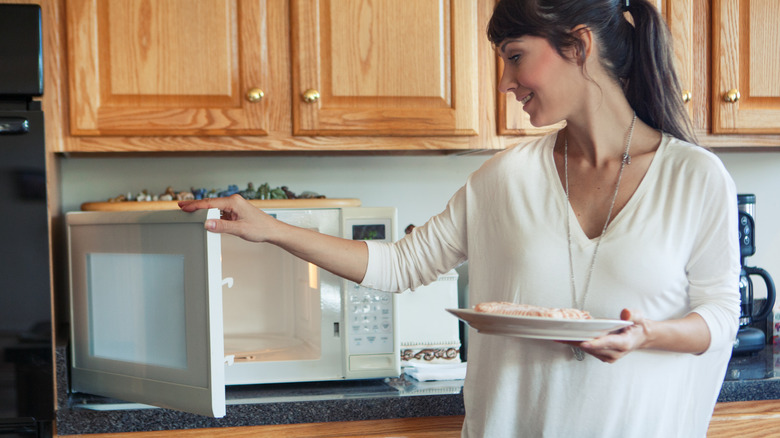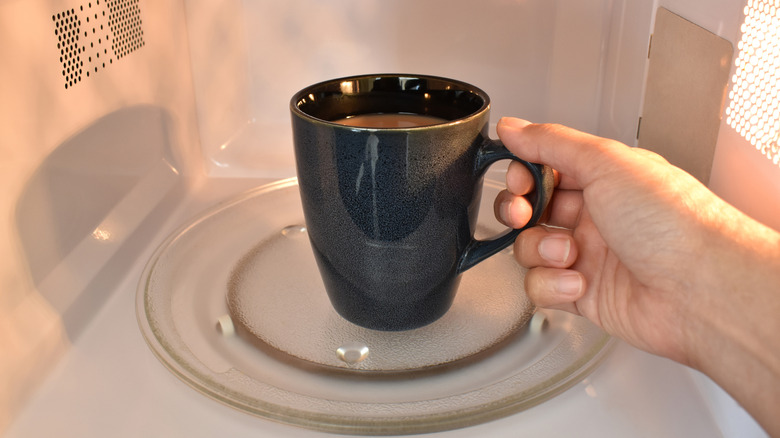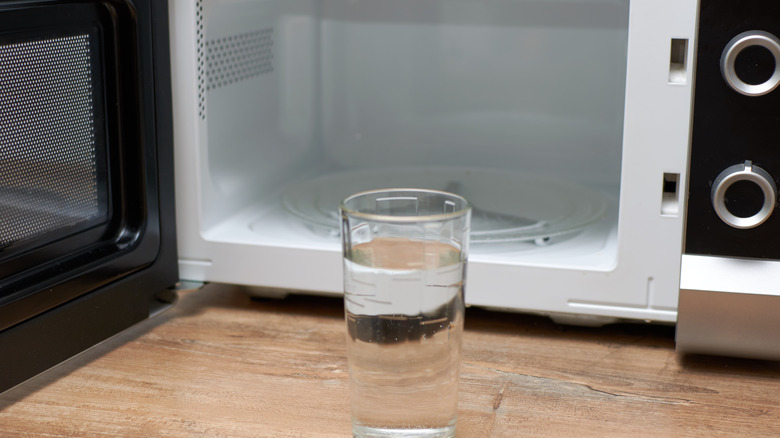How To Prevent A Microwave 'Eruption' According To The USDA
Microwaves are so commonplace in homes now that everything from cooking chicken drumsticks to heating a cup of water for tea is done in them. Who wants to use a kettle and stove when you can simply pop a mug of water in the microwave? But it turns out that there's a lot more to be careful about than never microwaving your food in plastic.
An eruption can occur when heating liquids in the microwave, warns the USDA. There is a chance that the water you heat inside a microwave will form bubbles and spill over when you add coffee grinds or a tea bag to it soon after you remove it from the microwave. And this is because of something called "superheating." So much for thinking that you can remove heated water from the oven without being worried about hot water splashing on your body or face.
According to the USDA, you can prevent the eruption by following a few simple steps: heat the water in a mug with an uneven surface, throw a microwavable object into the mug while you heat the water (like a wooden spoon), stop and stir the liquid at short intervals, and add coffee or tea contents to the water midway. If you don't understand how these tips will make a difference, knowing how microwaves differ from other heating sources when it comes to how they heat food should clear things up.
Microwave-heated liquid can go over its boiling point without actually boiling
Chemistry professor and social media content creator Kim Hilton (who goes by the name chemicalkim on Instagram) explained the concept of superheating. "When water is heated in a microwave, it can superheat without appearing to boil. This means the water can become hotter than its boiling point without actually boiling. And when it is disturbed or a surface is introduced for bubbles to form, it can rapidly boil and release steam, causing an explosion."
Microwaves heat food by sending out electromagnetic waves that cause vibrating water molecules inside the food (or liquid). Water usually reaches its boiling point at 212°F, per the USDA. "However, in some cases, the water can become overheated and superheated because it lacks the impurities and imperfections that would normally cause bubbles to form and help the water to boil," shared Hilton. The USDA notes that using a clean mug taken directly from the dishwasher or heating room-temperature water can cause eruptions, too. So can heating the water for too long (example: over three minutes). An uneven surface in a mug or throwing a non-metallic (wooden) spoon in with the water works by diffusing the heat and providing the space for bubbles to form while the liquid is heating.
Heating the water in 30-second increments, stirring occasionally, and waiting a while before removing the mug from the microwave are some other tips to prevent superheating. Again, the first two methods allow for more uniform heating that releases bubbles, while the latter step ensures the water is not past boiling point when you remove it from the oven.
Should you be heating water in the microwave at all?
There is nothing wrong with heating water in the microwave, per Healthline. The important thing to remember is to not overheat liquids and follow the steps recommended by the USDA.
But there is a chance that the water you boil for tea doesn't heat evenly in a microwave, per a 2020 study in AIP Advances. Yet another study published in Nature looked at how kettles differ from microwaves when it comes to uniformity of heating. Microwaved liquids end up being hotter on the top and colder on the bottom, while kettles heat water from the bottom up, ensuring all the water in the container is evenly boiled.
That being said, if you don't want to be switching on the kettle every time you want a cup of coffee (or tea) during the day, why not invest in a thermos? Spend a few minutes heating water on the stove or in a kettle in the morning, and pour the rest of the water into the flask for when you'll need hot water later in the day. You avoid the risk of eruption by using a microwave and have a far more efficient source of hot water for when you need it. Even though they are handy appliances, it's always best to be aware of the risks of cooking food in your microwave. Even something as simple as water can become dangerous when the proper preventive measures aren't taken.



